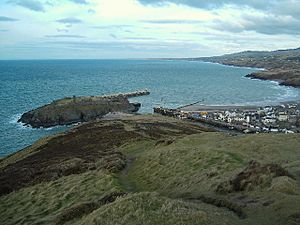St Patrick's Isle facts for kids
St Patrick's Isle (which is Ynnys Pherick in the Manx language) is a small island on the west coast of the Isle of Man. It's in the Irish Sea and is connected to the main island by a path that appears at low tide. Most of St Patrick's Isle is covered by the old Peel Castle, which has amazing and well-preserved ruins.
Contents
What is St Patrick's Isle?
St Patrick's Isle is a special place because it's a "tidal island." This means it's an island that can be reached by walking across a sandy or rocky path when the tide is low. When the tide comes in, the path gets covered by water, and it becomes a true island again! It's located off the coast of a town called Peel on the Isle of Man.
A Look at the Island's History
People have lived on St Patrick's Isle for a very long time, even as far back as the Late Bronze Age. This was thousands of years ago!
What Old Buildings Can You Find?
The island is home to several old buildings and ruins, including:
- St Patrick's Church
- An Irish-style round tower
- The former St German's Cathedral
- An old home for the Lords of Mann (who were like rulers of the island)
The old cathedral was left to fall apart in the 1700s and was never rebuilt. The island's steep and rocky edges made it a great place to defend against invaders.
How Did It Get Its Name?
It's believed that St Patrick, a very famous saint, first arrived on the Isle of Man in the year 444. He was on his way back to Ireland from Liverpool. After he helped bring Christianity to the island, he chose a bishop named Germanus to help the church grow. However, some people aren't sure if the name "St Patrick's Isle" was used before the 1200s. The island was originally called Inis Patraic or Ynnys Patraic in the Manx language.
Visiting St Patrick's Isle Today
Today, St Patrick's Isle is a popular place for tourists to visit. The old castle walls run right along the shoreline. You can even walk around the outside of the castle along the coast of the island.
How to Get There
The island is connected to the town of Peel by a special path called a causeway. This causeway crosses over a beach named Fenella Beach. The beach was named after a character in a book called Peveril of the Peak by Sir Walter Scott.
More Than Just History
Besides its amazing historical ruins, part of St Patrick's Isle is also a safe place for sea animals. It acts as a small wildlife sanctuary!
See also
 In Spanish: Isla de San Patricio para niños
In Spanish: Isla de San Patricio para niños



